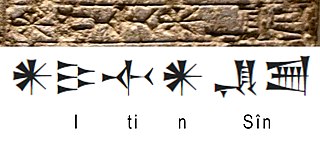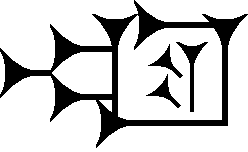 W
WARAD, is the capital letter-(majuscule) Sumerogram for the Akkadian language word "ardu", for servant. It is used especially in the introduction to the Pharaoh: for example "To King, Lord-mine, message thus Xxxxxx, "Servant-yours"-(271). It is also used extensively in Amarna letter texts, the author, usually the "man of a city",, where there is a constant reminder that he is a "servant", or "servant-yours"-(of the Pharaoh). Many letters are giving city-state status reports, but many are also requesting help with the Egyptian army troops-(Archers, supplied by the Pharaoh).
 W
WDingir is a Sumerian word for "god" or "goddess." Its cuneiform sign is most commonly employed as the determinative for religious names and related concepts, in which case it is not pronounced and is conventionally transliterated as a superscript "D" as in e.g. DInanna.
 W
WÉ is the Sumerian word or symbol for house or temple.
 W
WEhursag is a Sumerian term meaning "house of the mountains".
 W
WEkur, also known as Duranki, is a Sumerian term meaning "mountain house". It is the assembly of the gods in the Garden of the gods, parallel in Greek mythology to Mount Olympus and was the most revered and sacred building of ancient Sumer.
 W
WEnamtila is a Sumerian term meaning "house of life" or possibly "house of creation". It was a sanctuary dedicated to Enlil, likely to have been located within the Ekur at Nippur during the Akkadian Empire. It also referred to various other temples including those to later versions of Enlil; Marduk and Bel as well as one to Ea. It was likely another name for Ehursag, a temple dedicated to Shulgi in Ur. A hymn to Nanna suggests the link "To Ehursag, the house of the king, to the Enamtila of prince Shulgi we go!" Another reference in the Inanna - Dunmuzi text translated by Samuel Noah Kramer references the king's palace by this name and possibly makes references to the "sacred marriage": "In the Enamtila, the house of the king, his wife dwelt with him in joy, in the Enamtila, the house of the king, Inanna dwelt with him in joy. Inanna, rejoicing in his house ...". A fire is reported to have broken out next to the Enamtila in a Babylonian astronomical diary dated to the third century BC. The Enamtila is also referred to as a palace of Ibbi-Sin at Ur in the Lament for Sumer and Ur, "Its king sat immobilised in his own palace. Ibbi-Suen was sitting in anguish in his own palace. In E-namtila, his place of delight, he wept bitterly. The flood dashing a hoe on the ground was levelling everything."
 W
WERIM is the capital letter-(majuscule) Sumerogram for the Akkadian language word army, or "troops". The akkadian language word for army is ; consequently the cuneiform character for ERIM is also equivalent to sab, zab, etc.-(also using s-dot).
 W
WGAL is the Sumerian cuneiform for "great".
 W
WHubur is a Sumerian term meaning "river", "watercourse" or "netherworld", written ideographically with the cuneiform signs 𒄷𒁓. It is usually the "river of the netherworld".
 W
WHursag is a Sumerian term variously translated as meaning "mountain", "hill", "foothills" or "piedmont". Thorkild Jacobsen extrapolated the translation in his later career to mean literally, "head of the valleys".
 W
WSharur, which means "smasher of thousands" is the weapon and symbol of the god Ninurta. Sumerian mythic sources describe it as an enchanted talking mace. It has been suggested as a possible precursor for similar objects in other mythology such as Arthurian lore.
 W
WMa is a Sumerian word meaning "land" that in Sumerian mythology was also used to regard Primordial Land.
 W
WThe cuneiform sign MÁ, the Sumerogram is the sign for English language "ship", or "boat", Akkadian language eleppu. When written in cuneiform texts, MÁ is preceded by the determinative for items made of wood, namely GIŠ, (GIŠ. For ship, or boat it is written as: GIŠ.MÁ, or GIŠ.MÁ, .
 W
WMUNUS, or SAL is the capital-letter (majuscule) Sumerogram for the Akkadian language word "ṣuhārtu", young woman, or woman. The word is commonly used in the Amarna letters diplomatic letters, as well as elsewhere, for example in the Epic of Gilgamesh.
 W
WCuneiform TI or TÌL has the main meaning of "life" when used ideographically. The written sign developed from the drawing of an arrow, since the words meaning "arrow" and "life" were pronounced similarly in the Sumerian language.
 W
WThe cuneiform ud sign, also ut, and with numerous other syllabic uses, as well as multiple sumerogramic uses is a common sign for the mid 14th-century BC Amarna letters and the Epic of Gilgamesh. The sign is constructed upon the single vertical stroke , with various positionings of two wedge-strokes at the left, sometimes approximately centered, or often inscribed upwards to the left, the second wedge-stroke, occasionally inscribed/ligatured upon the first. The wedge-strokes can have any size, are often smaller than the vertical, but as an example, Amarna letter EA 256, can be almost as large as the vertical.
 W
WUkkin (UKKIN) is the Sumerian word or symbol for assembly, temple council or Divine council, written ideographically with the cuneiform sign 𒌺.
 W
WThe cuneiform sign ur (𒌨) is a common-use sign in the Epic of Gilgamesh, the Amarna letters, and other cuneiform texts. It has multiple sub-uses in the Epic of Gilgamesh, as well as use for the Sumerogram, UR. In the Epic, UR is used to spell Akkadian language barbaru, "wolf", as UR.BAR.RA.